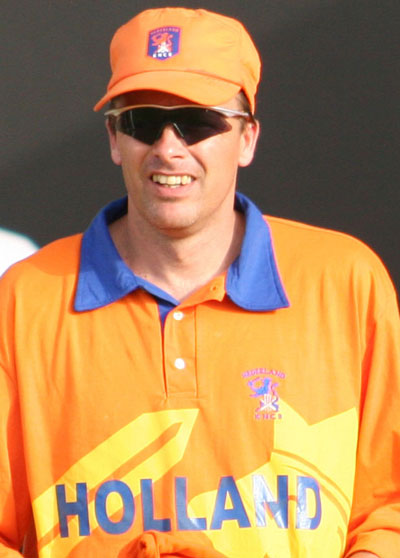
“It started as I guess it does for so many by playing on the street with my older brother Ernest. I think looking back I learned so much from the challenges of playing in the driveway with tennis balls and the competitive element within the family circle and also in the schoolyard.
“We had a good group of friends, all around the same age and we helped and learned from each other. We played for six or eight weeks at the club, there was no holidays. Nowadays if you want kids to play they have to more or less be invited and have practises scheduled. The normal way we just turned up and played has all but gone.
“In those days we were inspired by the West Indian team of the 1970s. They played exciting, attacking cricket and you tried to emulate it. My father was also at the club so you graduated towards there. He wasn’t the greatest player by any means, but he loved the game and played it all his life. We certainly caught the bug. It was in the blood, very much in our system.”
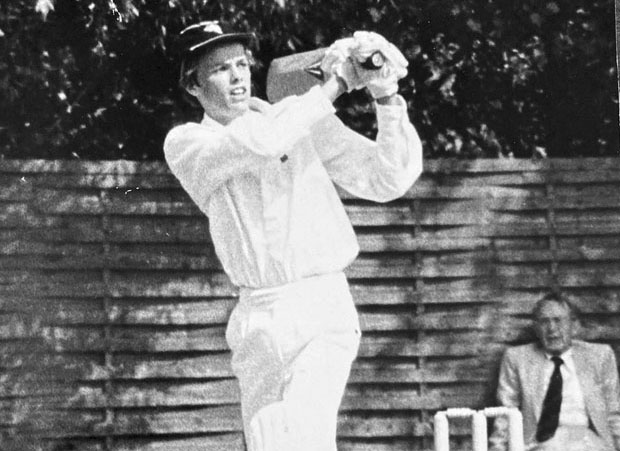 The young Roland Lefebvre in action
The young Roland Lefebvre in action
That club was VOC in Rotterdam and Roland would play the majority of his cricket in Holland there. He made his debut aged 15 and with Ernest, who would also go on to play for Holland, VOC proved a real force in Dutch cricket as they captured four titles in the space of six years in the 1980s.
Ernest was himself a very useful all-rounder who emigrated to South Africa in 1990 and went on to be named their Cricketer of the Year in a side packed with talent.
Our interview comes at an opportune time because the Covid-19 pandemic has focused Roland’s mind on putting his affairs in order. A keen collector of all things cricket, he has amassed quite a collection of scrapbooks of memorabilia from his breakthrough into club cricket and also during his time with the international side. He has folders on his time with Glamorgan, Somerset, and with Canterbury in New Zealand. He’s in the process of archiving it all, not saying goodbye to life but a perfect opportunity to get everything in some semblance of order for future generations and historians of the game.
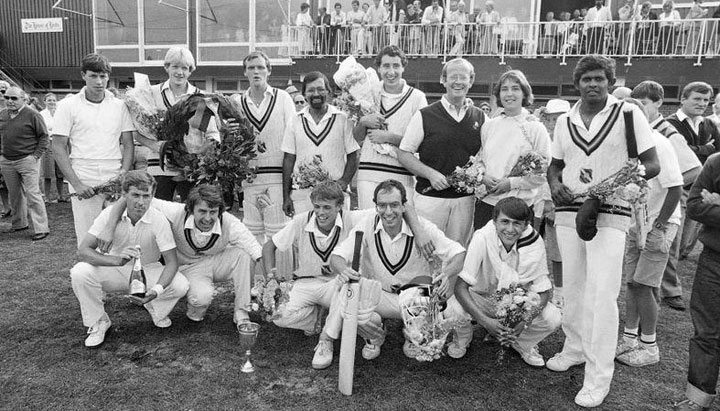 Enjoying victory with VOC
Enjoying victory with VOC
Originally a leg-spinner who batted, Roland changed to bowling pace at the suggestion of VOC skipper Rob van Weelde, who was a former national team captain.
“In those days as a young leg-spinner it was hard to get your overs as you are establishing yourself. There were other spinners who were more experienced and at that stage probably better, plus as Terry Jenner always said you have to give leg-spinners a bucket of runs, and the worst thing to do with his confidence is to take him off after one over so you have to give him 30 or 40 runs to play with.
“I wasn’t getting a lot of overs and towards the end of the 1980 season I was starting to bowl pace in the nets. I wanted to be involved. One match Rob came to me and said I want you to bowl pace. It worked out well and I took 3 for 15 in 15 overs and never looked back.
“That winter I trained with him and did a lot of work on my physique, doing a lot of running to put strength in my legs and also running up hills. I started the 1981 bowling pace and continued, never going back to leg-spin. It helped that I was very successful quite quickly. I found that I had a natural accuracy from the start and hit a length right away.”
His success at club level with VOC soon led to international recognition and he was awarded his first cap against The MCC in 1983 at the age of just twenty. He would go on to play 162 times for Holland, taking 200 wickets for the Oranje placing him fifth on the all-time aggregate list, while also scoring 2876 runs, including two centuries.
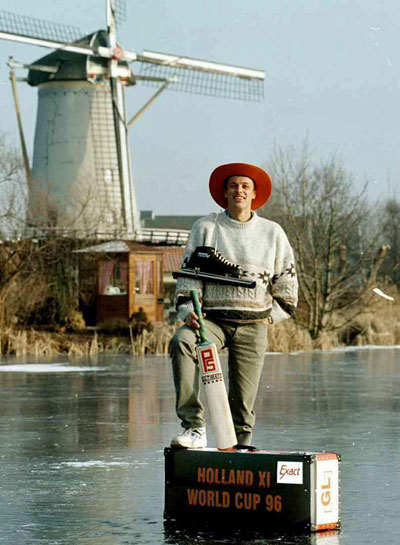 Before the 1996 World Cup
Before the 1996 World CupHe was often at his best in the ICC Trophy, playing in five tournaments between 1986 and 2001, helping The Netherlands qualify for the 1996 and 2003 World Cups. In 43 ICC Trophy games he took 71 wickets at just 11.64 (a record), while his economy rate was a miserly 2.47. A trait he would carry with him all his career. He just hated conceding runs.
Following the 1986 Trophy he played a few games with Hampshire Seconds along with PJ Bakker, who became the first Netherlands player to play first-class cricket. In one match against Middlesex who had Mark Ramprakash, Angus Fraser and Mike Roseberry in their ranks, the pair took all ten wickets to fall, with PJ getting five plus a run-out and Roland four. Bakker forged a successful career with Hampshire and although nothing came of his time with Hampshire, it wasn’t long before Lefebvre would join him in the County Championships.
He had just qualified as a trained physiotherapist in 1987 and spent two seasons in Auckland in New Zealand before getting his big break into the county scene.
“I was qualifying for MCC in 1989 and played three matches including a two-day game against Ireland at Lord’s. Martin Crowe of Somerset was captaining the side, and also in the same season an England XI came over to Holland to play two matches. It was just after they had announced there was going to be a rebel tour going to South Africa so there was a lot of focus on this side. Peter Roebuck played in the games and I bowled reasonably well.
“So you had Martin, Peter and also Somerset coach Jack Birkenshaw had been receiving good reports about me so it all came together. I got invited over for a trial in September 1989 and played for the second XI in a three-day match against Glamorgan, and even before the end of the second day they had offered me a three year contract.
It was a strong Somerset side who were recovering after the fall-out a few years previously when Ian Botham, Joel Garner and Viv Richards all left the club. Chris Tavare was captain, David Graveney had joined from Gloucestershire, Martin Crowe was there Peter Roebuck, Neil Mallender plus South African Jimmy Cook, who he describes a ‘real run machine’.
“Jimmy was funny though in that if he was netting pre-match he never played a shot and was very subdued. He was more concerned about lining himself correctly and transfer of weight. Then when you saw him in the middle, he often got off to a flying start, hitting the ball everywhere against Walsh or Marshall and you were like ‘Wow, where did that come from?’ He was a real accumulator and he scored 313 not out against Glamorgan in early May of 1990.”
Lefebvre made an instant impact at Somerset and on his debut first-class appearance in the Championship took 5 for 30 against Gloucestershire and later that season claimed 7 for 15 against Devon in the NatWest Trophy. He also helped them to the semi-finals of the Benson and Hedges Cup but missed out to a Wasim Akram and Neil Fairbrother inspired Lancashire.
He fell in love with the area and the people and became very popular with the West Country supporters who loved his style of play where they could see he gave everything.
”I had a great rapport with the Somerset fan and it was a really great place to both live and play. For me it was really a dream come true. As a kid in Rotterdam I had posters of players like Gooch and Gower, then you are bowling to them. It was quite surreal.
“That’s not to say it was all one-way. I remember facing Surrey and Waqar Younis and going into bat when we were 25 for 6! I think I got 49 so that was memorable.”
At the end of his first season with Somerset, he returned to New Zealand playing first-class and List-A cricket with Canterbury where he recorded his best first-class bowling figures taking six wickets against Auckland. Back in England he made his only first-class hundred for Somerset when he scored exactly 100 against Worcestershire at Weston-Super-Mare.
However just before the start of the 1992 season while on a tour of the Leeward Islands with MCC he broke his left arm in two places which required surgery back in England, and the insertion of two metal plates. Somerset had a new coach in Bob Cottam and despite recovering by the start of June, he found himself out of favour. The coach was going with youth and although Somerset’s results were poor, Lefebvre couldn’t force his way back into contention.
Somerset CEO Peter Anderson called him in and told him that he was free to talk to other counties as Cottam was on a five-year deal and that the club had to back the coach. There were no shortage of offers for the affable Dutchman with Surrey, Durham, Gloucestershire and Glamorgan amongst six counties expressing an interest. Having weighed up all his options he plumped for the Welsh side and had no regrets.
“It worked out very well for me. They were certainly the right county for me and were the right fit. We were very successful in the three seasons there, especially in the one-day game.”
It was a strong Glamorgan side who had perhaps underachieved. Players of the calibre of Hugh Morris, Steve James, Matthew Maynard, Robert Croft, Steve Watkins, Adrian Dale and West Indian legend Viv Richards.
1993 was the last season in professional cricket for Sir Vivian Richards and he went out on a winning note as Glamorgan beat Kent to clinch the Sunday League ending a 24-year trophy drought with Richards and Tony Cottey sharing a 70-run stand in a six wicket win.
“I was the missing link in that Glamorgan side, I was the guy who bowled his ten overs for 20 odd and it was just what they needed. We also reached the semi-finals of the NatWest and finished third in the County Championship.
“It was crazy really because at the start we were bottom after four or five games but then won 12 on the trot to lift the trophy.
“I had a great bowling partnership with Steve Watkin in that competition. I would bowl eight overs straight up at the start when there were the 15-over fielding restrictions with just two allowed outside the circle, and then come back and bowl overs 47 and 49.
“In the four-day matches I bowled a lot with Steve Barwick who was incredibly accurate. That was the hallmark of that Glamorgan team, as we weren’t blessed with outright pace. We scored our runs incredibly quickly and also our over rate was just incredible. I remember in one match bowling 42 overs in 2 hours 15 minutes.”
Not content with sharing a dressing room with Richards, Lefebvre had the privilege of being driving buddies with Sir Viv, travelling up and down the motorways of England on their way to matches.
“He was great to talk to. We had some wonderful conversations and of course not just about cricket. He was very much for the rights and advancement of black people which is a very hot topic now. He was 30 years ahead of his time. He’s always been very forthright in his views and was a real role model for so many people.”
For Lefebvre there was immediate acceptance at both Somerset and Glamorgan, helped by the fact that he gained his county cap at both within three months,
His county career came to an end when in the 1995 season he suffered a severe groin injury at Swansea in July where he ripped his adductor muscle.
“It was very, very painful and I saw a lot of specialists. We opted for conservative treatment and I played one more match in September. Later that winter I played in the World Cup but was only about 70%. Later in pre-season I went to South Africa with Glamorgan and although I could bowl it soon became pretty apparent that I was nowhere near the level you needed to be at for professional cricket to be able to fulfil your obligations so I retired.”
Although not able to play county cricket he continued in the international arena where the rigours were not so hard on his body, given the relatively low number of games each year. He was able to play internationally for seven more years, with one of the highlights being the 2001 ICC Trophy in Canada where they won the competition to qualify for the 2003 World Cup.
“That tournament was just unbelievable. We had so many close matches. We should have lost to Ireland as we were behind for 90% of the game. The turning point was the run out of Jason Molins. I bowled the last over with six runs needed and we won by two runs. I loved the pressure situations.
“Of course in the game against UAE early on we looked in trouble as we only made 144. However I took 5 for 16 and they only made 54 having been 17 for 7 at one stage, We beat Namibia off the final ball in another crazy game that we looked to have lost but won. The hallmark of a great team. We had some super players who never knew they were beaten.
“I knew that I was coming towards the end of my career as I was 38 when we won the ICC Trophy and would be 40 by the time of the World Cup. What better way to bow out than at a World Cup?”
During the 2003 tournament, despite being at the start of his fifth decade, he was still as frugal as ever.
“I didn’t get that many wickets but my economy rate was 3.7 – against India I took 1 for 27, dismissing Saurav Ganguly as we restricted them to 204, while versus Australia I bowled eight overs for 19 runs against the likes of Matthew Hayden in the power-play.
“This stems back to my hate of any batsman scoring a run off me. I knew how many I had conceded off every spell. My perfect spell would have been 0 for 0 off ten overs or maybe 2 for 0. It’s all about control. If I don’t make a mistake you control and frustrate the batsman and build the pressure.”
Against Zimbabwe he took 2 for 38 and scored 30 in what proved to be his last appearance for the national side.
“My final match was supposed to be the World Cup match against Namibia which we won thanks to centuries from Feiko Kloppenburg and Klaus van Noortwijk but I had to declare myself unfit.
“I had a hamstring twinge and took a fitness test on the morning of the game. It just didn’t feel right. You can imagine that was with a heavy heart but I had to think of the team rather than for selfish personal reasons. You play for the team. By all means you can have individual skill and brilliance, but selfishness has got no place in cricket.”
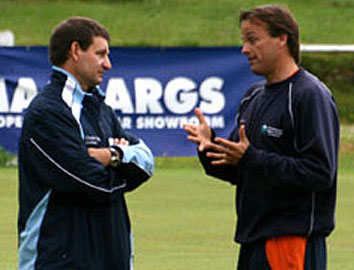 In discussion with former Scotland coach Peter Drinnen
In discussion with former Scotland coach Peter Drinnen
In 2002, he started to work for the KNCB, the governing body of cricket in The Netherlands, so when retirement from playing came he was still involved in the coaching ranks. As anyone who has ever been involved with coaching or administration below Full membership, a can-do attitude and multifunctional skill traits are necessary where support personnel are limited and funding even more limited.
“We were a very small organization and I was doing all the work with youth cricket, coach development and all that kind of stuff. That’s how life was in the Associate world, you don’t get things handed on a silver plate.
“As time has progressed things have grown as we have become more successful and I’m now the High Performance Manager. It’s hard work both at the top elite level and at the bottom with development but enjoyable.
“We are professionalizing and would like Full Member status, although I can’t see us playing Tests as we have no chance of playing first-class cricket in Holland.
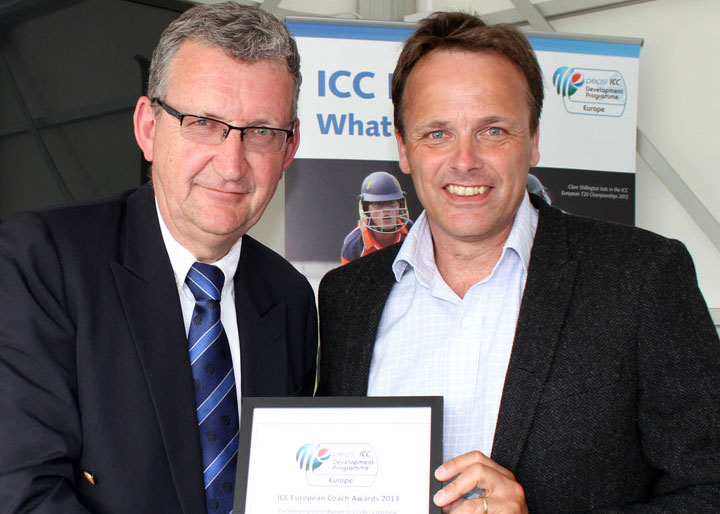 Receiving a European Coaches Award in 2013
Receiving a European Coaches Award in 2013
“It would be great to get the security that it brings. People don’t realise what is at stake all the time. You can be one ball, one mistake away from losing the majority of your funding for two years. That’s real pressure and real challenges.
Pressure, challenges – sounds like the KNCB have exactly the right man to handle the job….
